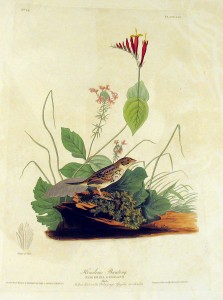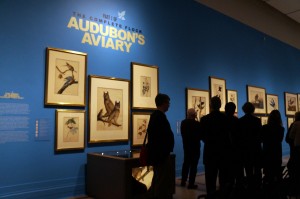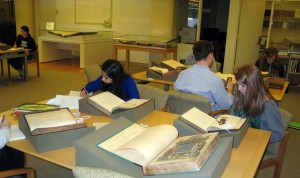 “If the name of Starling has been given to this well-known species, with the view of assimilating it to the European bird of that name, it can only have been on account of the numbers of individuals that associate together, for in every other respect it is as distinct from the true Starlings as a Common Crow. But without speaking particularly of generic or specific affinities, I shall here content myself with giving you, kind reader, an account of the habits of this bird.
“If the name of Starling has been given to this well-known species, with the view of assimilating it to the European bird of that name, it can only have been on account of the numbers of individuals that associate together, for in every other respect it is as distinct from the true Starlings as a Common Crow. But without speaking particularly of generic or specific affinities, I shall here content myself with giving you, kind reader, an account of the habits of this bird.
The Marsh Blackbird is so well known as being a bird of the most nefarious propensities, that in the United States one can hardly mention its name, without hearing such an account of its pilferings as might induce the young student of nature to conceive that it had been created for the purpose of annoying the farmer. That it destroys an astonishing quantity of corn, rice, and other kinds of grain, cannot be denied; but that before it commences its ravages, it has proved highly serviceable to the crops, is equally certain.
As soon as spring makes its appearance, almost all the Redwings leave the Southern States, in small detached and straggling flocks, the males leading the way in full song, as if to invite the females to follow. Prodigious numbers make their appearance in the Eastern Districts, as winter recedes, and are often seen while piles of drifted snow still remain along the roads, under shelter of the fences. They frequently alight on trees of moderate size, spread their tail, swell out their plumage, and utter their clear and not unmusical notes, particularly in the early morning, before their departure from the neighbourhood of the places in which they have roosted; for their migrations, you must know, are performed entirely during the day.
Their food at this season is almost exclusively composed of grubs, worms, caterpillars, and different sorts of coleopterous insects, which they procure by searching with great industry, in the meadows, the orchards, or the newly ploughed fields, walking with a graceful step, but much quicker than either of their relatives, the Purple Grakle or the Boat-tail of the Southern States. The millions of insects which the Redwings destroy at this early season, are, in my opinion, a full equivalent for the corn which they eat at another period; and for this reason, the farmers do not molest them in spring, when they resort to the fields in immense numbers. They then follow the ploughman, in company with the Crow Blackbird, and as if aware of the benefit which they are conferring, do not seem to regard him with apprehension.”
–J. J. Audubon, Ornithological Biography, I (1831), 348-349 [excerpted].
 “I obtained the bird represented in this plate opposite Cincinnati, in the State of Kentucky, in the year 1820, whilst in the company of Mr. ROBERT BEST, then Curator of the Western Museum. It was on the ground, amongst tall grass, and exhibited the usual habits of its tribe. Perceiving it to be different from any which I had seen, I immediately shot it, and the same day made an accurate drawing of it.
“I obtained the bird represented in this plate opposite Cincinnati, in the State of Kentucky, in the year 1820, whilst in the company of Mr. ROBERT BEST, then Curator of the Western Museum. It was on the ground, amongst tall grass, and exhibited the usual habits of its tribe. Perceiving it to be different from any which I had seen, I immediately shot it, and the same day made an accurate drawing of it.






